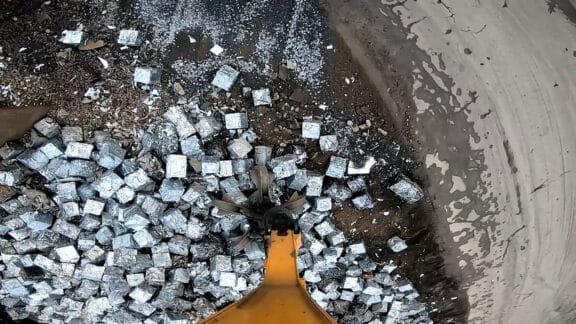What will tomorrow’s world look like—a world that has implemented the innovations pioneered today? A world based on the groundbreaking technological, social, and political ideas that have only just surfaced? In this series, Metals Magazine’s independent editor James Gray takes a peek into his crystal ball and lets us know what the future holds for our carbon footprint.
Over the last few years, there has been growing emphasis on “going green.” The phrase refers to striking a balance between the life you lead, the impact of your life choices on the planet, and being mindful enough to help maintain ecological balance. Our planet is growing at an unsustainable rate, with the global population expected to hit 9.8 billion people by 2050. At that rate, it would take two planets to support current consumption.
However, in 2010, an unexpected development unfolded when U.S. greenhouse gas emissions fell by around 10 percent, primarily as a result of self-isolation during the Covid pandemic. This unforeseen change of events represents the largest drop in greenhouse gas emissions since World War II. Leading the decline was the transportation sector, where emissions dropped a massive 14.7 percent against 2019 levels as people travelled less. Power plant emissions witnessed the second largest decline, dropping 10.3 percent below 2019 levels. In a way, Covid showed that our actions as individuals can make a significant difference in lowering our effective carbon footprint. The question is, what more can we do?
Studies show that 20 percent of greenhouse gases are generated by households. In fact, most of an individual’s carbon footprint will usually come from transportation, food, and housing. But if we’re to have any chance of preventing substantial climate change—which means avoiding a 2 °C rise in global temperatures—, we will need to reduce our carbon emissions to under 2 tons per person by 2050.
Covid prompted the largest drop in greenhouse gas emissions since 1945. This proves that our actions as individuals can make a significant difference in lowering our carbon footprint. The question is, what more can we do?”
A Smarter Lifestyle
One of the easiest ways to reduce your carbon footprint is by using smart devices. These use Artificial Intelligence (AI) to learn your routines and habits as time goes on. They can also track and monitor your home to improve energy efficiency. Smart devices such as thermostats and home appliances are usually connected to the internet via Wi-Fi or Bluetooth. This allows you to control them using a smartphone or tablet. Left for work or vacation and forgot to turn off the lights? No problem with an app on your mobile device.
Some smart devices can learn your day-to-day routines using AI. For example, smart water heaters can track your hot water usage. Let’s say you do your laundry or prefer to take a shower in the evening. Your smart water heater will adjust its heating times to match your schedule, so that less energy is used to keep the water hot throughout the day. If your utility providers have off-peak tariffs, AI-based smart scheduling can reduce energy consumption and save you money.
Home devices like smart meters can also communicate with modern electric grids, forming a complex network. Two-way communication between smart grids and smart devices can help to ensure that energy is delivered more efficiently. Artificial Intelligence is a game-changer. AI can quickly sift through vast amounts of data to recognize patterns and make predictions. Think about how Netflix suggests shows based on your past viewing. It’s the same kind of technology. Climate scientists have jumped on the technology and are adapting it to predict climate change.

SMART THERMOSTATS
It’s estimated that using a smart thermostat could save the average household up to 12 percent on heating costs and 15 percent on cooling. Smart thermostats can match your schedule. There’s no need to have the heating turned up when nobody’s home, but you can program your smart thermostat or use a mobile device to switch on the heating before you arrive home.

SMART LIGHTBULBS
You can control Wi-Fi-connected smart lightbulbs using an app on your mobile device. You can also program them to turn on and off, saving energy and lowering your lighting costs. Left the lights on by accident? Simply use your mobile device to turn them off. You can even use your app to dim them and save electricity.

SMART PLUGS
If you don’t have a full smart home setup yet, smart plugs are a good place to start. They work by plugging into any electrical outlet. You can then control the energy consumption of whatever you plug into them. Using apps, you can also program times of use or turn appliances on and off remotely.

SMART APPLIANCES
Yes, even your kitchen appliances can talk to you. Left your refrigerator door open? It will let you know via an app on your mobile device. Gremlins in the washing machine? Get notified of the problem and repair your appliance quickly in order to avoid the expense of a completely new washing machine.

SMART SPRINKLERS
Maximize water usage and cut your water bill with a smart sprinkler system. These systems use real-time weather data and set your lawn watering time to match. So you won’t have to worry about watering your lawn during a downpour or end up with underwatered grass on a hot, dry day.
Switch to Green Energy
Renewable energies are becoming increasingly accessible and affordable. Energy providers are now offering greener tariffs and by switching to a company that provides electricity from renewable energy—that is energy that comes from continually replenishing sources—you can reduce your household emissions and save money on your utility bills. Solar, wind, or hydroelectric energy are good examples. A 100 percent green supply means that all the electricity you consume is “matched” by purchases of renewable energy—such as wind farms and hydroelectric power stations. With more and more people switching to renewable energy, investment in these technologies is increasing and eventually renewable energy prices will fall.
If you’re unable to switch home energy supplier, you can still make changes to reduce your dependence on fossil fuels. For instance, you can install solar panels or a solar water heater, or use solar powered tech like outdoor or portable lighting or mobile phone power banks.
There are also steps you can take to reduce household energy consumption. For example, try installing only LED lights in your house and choosing energy-efficient appliances and heating and cooling solutions. Make sure your home is properly insulated with appropriate heat trapping or cooling materials. This will reduce the amount of energy needed to warm or cool your home, which is both kinder on the planet and your pocket.
Can We Still Eat Meat?
Experts agree that cutting down on meat—red meat in particular—is a better choice for the environment and reducing our carbon footprint. Why? Because the production of red meat involves the use of so much feed, water, and land. Plus, cows themselves emit methane, a harmful greenhouse gas. According to the figures from a comprehensive scientific study conducted in the last couple of years, meat and dairy account for just 18 percent of our calories and 37 percent of our protein intake, the livestock footprint takes up 83 percent of farmland, and meat and dairy production is responsible for 60 percent of agriculture’s greenhouse gas emissions.
One way to address this obvious inefficiency is to actually grow meat in the laboratory. Lab-grown meat solves the land use problem while still allowing meat to be consumed. Food tech companies are exploring different ways to produce beef and seafood, for example, from animal cells. No need to raise livestock—or rely so heavily on feed, water, fertilizers, and fuel. Growing meat and fish in a lab involves taking cell samples from animals and extracting stem cells, which have a high reproduction rate. The cells are then treated with a protein that promotes tissue growth. A bioreactor—think of it as an artificial womb—is used to maintain the proper environmental conditions to support tissue growth. The new cell tissues can then be attached to a scaffold mesh so that three-dimensional steaks and fillets are formed.
Reducing our carbon footprint isn’t a new concept. But given the emerging technologies geared toward more sustainable, cleaner living, it’s becoming much easier for individuals to save energy and help to erase some of the damage. This is an exciting time to start putting your love of technology to good use to reduce your carbon footprint—in order to leave this world in a better state for future generations.
What are some of the ways that businesses can offset the rise in emissions or even achieve carbon neutrality? From the vehicles we drive and the fuel we use to power them to the way we manufacture products or grow our food, greenhouse gas emissions are a constant concern. Here are just a couple of emerging technologies to reduce our carbon footprint.

Fuel Additives
Fuel additives can be used to enhance performance, for example by improving the capabilities of your vehicle’s engine. They can also be used to stabilize fuel to keep it in a functional condition while being stored for extended periods. Fuel additives can help save fuel, reduce emissions, prolong engine life and boost the cleanliness and performance of gasoline, diesel, and bio-fuel.

Green Cement
It’s estimated that the world uses four gigatons of cement per year in construction. Limestone needs to be heated to over 2,700 degrees in a chemical reaction that releases huge amounts of CO2. One company, Solidia, has developed a “green cement” technology that allows cement to be fired at lower temperatures, slashing emissions by one third. The technique cures concrete using CO2 gas, which is embedded in the concrete. Solidia claims that if its technology were adopted industry-wide, it could lower annual CO2 pollution and carbon footprint by 1.5 gigatons and save 3 trillion liters of water.

Hydrogen-Powered Vessels
According to Marine Digital, the global shipping fleet accounts for 2.2 percent of global CO2 emissions. What’s more, big ships burn tons of low-quality “bunker fuel” that can pollute the air with toxic particulates. A partnership between Scandinavian nations is building a ferry to connect Oslo and Copenhagen by 2027. It will be powered by hydrogen fuel cells that create energy from hydrogen gas and release only water. The ferry will avoid 64,000 tons of CO2 annually.

Hydroelectric Dams
It can be a challenge to site large-scale solar installations in densely populated countries. Floating solar installations on hydroelectric dams can exploit unused aquatic surfaces, and a new floating solar plant in South Korea will be the world’s largest at 41 MW. The Korean plant will provide power for 60,000 people. But with more than 150,000 square miles of man-made reservoirs world wide, floating solar has a “potential on a terawatt scale,” according to the World Bank.
Learn more about “going green” at Primetals Technologies in “What is Green Steel?”
DID YOU KNOW …?
… that an internet connection via 4G has twenty times more impact in terms of energy use compared with Wi-Fi? This is because high-speed communication technology via mobile networks places considerable demands on base stations.
… that storing an email emits 10g of CO2 on average per one year’s storage, which is equivalent to a light bulb turned on for one hour? So empty your trash and delete emails you no longer need!
… that inactive browser tabs still consume energy even if they are not being viewed? You can try using a browser extension that suspends the activity of a tab after a given period of time.
… that streaming accounts for more than half of the world’s internet traffic through subscription services such Netflix, Amazon Prime, and platforms like YouTube? Try watching fewer videos or downloading music onto your phone rather than streaming it.


